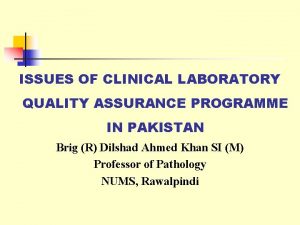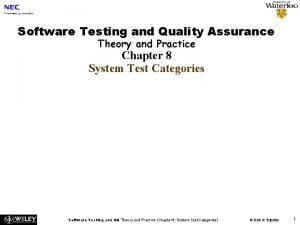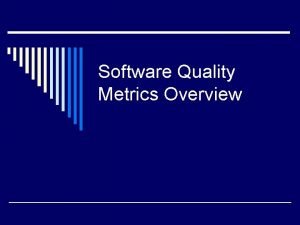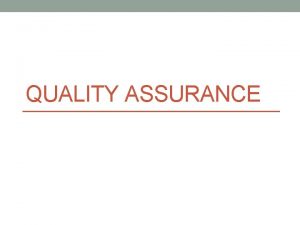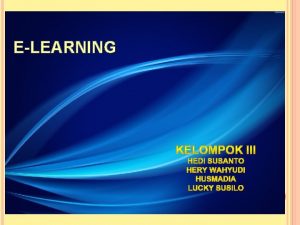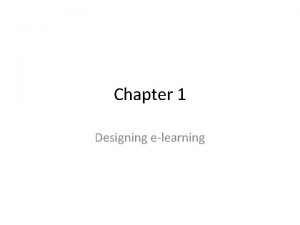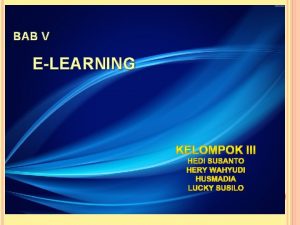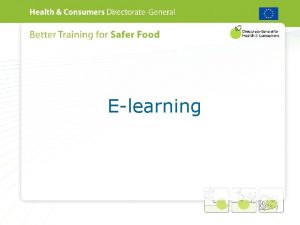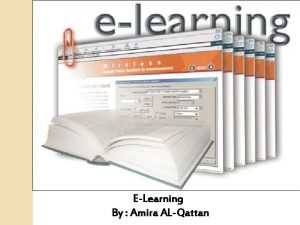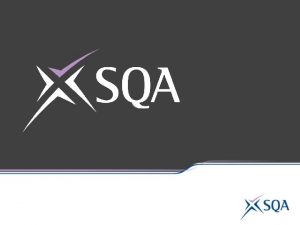Quality Assurance in eLearning Quality Assurance in e















- Slides: 15

Quality Assurance in e-Learning Quality Assurance in e. Learning

Quality Assurance in e-Learning • Quality assurance is not just controlling of the effects of e-learning, there also some other influential factors. • Here, one should also consider all factors having an impact on both educational settings and products at all stages of e-learning; namely learners, content, tutor, learning outcomes and environment, technological infrastructure, social surrounding, usability of elearning software, management, learning culture and interaction patterns.

Quality Assurance in e-Learning • In software and information products, quality usually includes both the conformity and service views; hence, it is a synthesis of conformity, adaptability, innovation and continuous improvement. • In higher education, as cited in the report by IIEP-UNESCO (2011), Green (1994) considers the quality from five different perspectives: • in terms of the exceptional (highest standards); • in terms of conformity to standards; • as fitness for purpose; • as effectiveness in achieving institutional goals; and • as meeting customers‘ stated or implied needs

Quality Assurance in e-Learning Basic Terminology about Quality • Statistics and Indicators • Systematic data collection, including primary and derived data with or without any value-addition, are called “statistics”. It means the building blocks of all the value-added specific terms, which will be discussed later. For example, details such as student enrolment, academic calendar and fee structure are called as statistics. When statistical terms or data are interpreted and used to indicate something, then they become “indicators” (IIEP-UNESCO, 2011).

Quality Assurance in e-Learning Basic Terminology about Quality • Performance Indicators • The indicators used to evaluate an institution or judge the effectiveness of a programme are often called as “performance indicators”. • The success of a system or institution is related with its productivity regarding with the effectiveness and efficiency. As a result, one may often come across Effectiveness Indicators and Efficiency Indicators in this context. Effectiveness indicators • completion rates • employment rates • graduate rates • student satisfaction Efficiency indicators • staff-student ratios • space utilisation • time to graduation • unit costs

Quality Assurance in e-Learning Basic Terminology about Quality • Standards • In higher education and quality assurance, a “standard” denotes a principle (or measure) to which one conforms (or should conform) by which one‘s quality (or fitness) is judged. It also has other meanings, such as “degree of excellence required for a particular purpose” or “a thing recognised as a model for imitation”. • In certain contexts, it means “basic”, without any value-addition features, or “average quality” or minimum requirements.

Quality Assurance in e-Learning Basic Terminology about Quality • Criteria • A criterion is an aspect or a feature by which a concept is evaluated. The International Network for Quality Assurance Agencies in Higher Education (INQAAHE) glossary (www. qualityresearchinternational. com/glossary) defines criteria as “specifications or elements against which a judgment is made”.

Quality Assurance in e-Learning Basic Terminology about Quality • Benchmarks • A benchmark is a point of reference to make comparisons. A benchmark was originally a surveyor‘s mark on a wall, pillar, or building which was used as a reference point to measure the altitudes. • It is defined in INQAAHE glossary as a process that enables comparison of inputs, processes or outputs between institutions (or parts of institutions) or within a single institution over time (IIEP-UNESCO, 2011).

Quality Assurance in e-Learning Quality of e-Learning • The Swedish National Agency for Higher Education (2008) have developed a model named as ELQ (e-learning quality), based on the investigation of European policies, projects and practices from national organisations and together with the current research.

Quality Assurance in e-Learning Quality of e-Learning • This model contains criteria for quality assessment of e-learning in higher education. These 10 criteria are: • Material/content • Structure/virtual environment • Communication, cooperation and interactivity • Student assessment • Flexibility and adaptability • Support (student and staff) • Staff qualifications and experience • Vision and institutional leadership • Resource allocation • The holistic and process aspect

Quality Assurance in e-Learning Quality of e-Learning • In the report written by Academic Partnerships (2014) ten common aspects are defined for quality experience in online learning environment as: • Institutional support (vision, planning, & infrastructure) • Course development • Teaching and learning (instruction) • Course structure • Student support • Faculty support • Technology • Evaluation • Student assessment • Examination security

Quality Assurance in e-Learning Competencies of e-Tutors • Online teachers (called as e-instructors or e-tutors) should possess more qualities and skills, especially regarding with technological innovations, than a traditional teacher does (Davis, et al. , 2007). • These qualities and skills systematically construct the e-competencies of online teachers. Guasch, Alvarez and Espasa (2010) used competency as an operative concept in their studies. They defined it as “…a system of complex actions including the knowledge, abilities and attitudes required for the successful completion of tasks” (p. 200).

Quality Assurance in e-Learning Competencies of e-Tutors • Williams (2003) categorised the e-competencies of teachers as communication and interaction, instruction and learning, management and administration, use of technology. • Smith (2005) described 51 e-competencies for teachers. Overall, all these e-competencies are categorised into three main headings: competencies needed before the course, competencies needed during the course and competencies needed after the course.

Quality Assurance in e-Learning Learner Satisfaction • Satisfaction of online learners is one of the crucial factors affected from the whole process, which has direct evidence about the quality of e-learning. • It may also be considered as a determinant of how successful the course, programme, instructor as well as selected technologies and design is based on the scope of the questions asked.

Quality Assurance in e-Learning Conclusion • There are many aspects of an e-learning system if you really want to guarantee success in your online programme. You have to evaluate many aspects such as your learner, content, tutor, programme, infrastructure, human resources. • If you want assess satisfaction of your learners you can consider the criteria suggested by Rothman et al. (2011) as: (1) Appropriateness of Readings and Assignments, (2) Technological Tools, (3) Instructor Feedback and Communication, (4) Course Organisation, (5) Clarity of Outcomes and Requirements and (6) Content Format.
 Compliance vs quality
Compliance vs quality Plan quality management pmp
Plan quality management pmp Quality control concepts
Quality control concepts Quality metrics pmp
Quality metrics pmp Ana model of quality assurance
Ana model of quality assurance Quality control and quality assurance
Quality control and quality assurance The isle quality assurance
The isle quality assurance Faa foqa
Faa foqa Pharmacovigilance quality assurance
Pharmacovigilance quality assurance Neqapp
Neqapp Quality control card
Quality control card Call may be monitored for quality assurance
Call may be monitored for quality assurance Software testing and quality assurance theory and practice
Software testing and quality assurance theory and practice Quality assurance for school development
Quality assurance for school development Qat quality assurance testing
Qat quality assurance testing Cuprimdso
Cuprimdso









